Spinning, spinning "Charles de Gaulle"
Ships of this class in various states, despite their versatility, have specificity. That is, the nomenclature of tasks is about the same, but the value of each of them is significantly different. It is estimated by weighting.
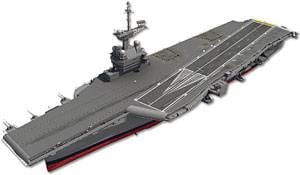 The experience after the Second World War showed that aircraft carriers are actively used in armed conflicts and local wars of various sizes. And they will be one of the main components of the groups of opposing fleets with the start of large-scale hostilities. Accordingly, it is necessary to consider both variants of combat use conditions.
The experience after the Second World War showed that aircraft carriers are actively used in armed conflicts and local wars of various sizes. And they will be one of the main components of the groups of opposing fleets with the start of large-scale hostilities. Accordingly, it is necessary to consider both variants of combat use conditions.The main tasks for which we will compare the following: the destruction of carrier-assault and multipurpose groups, large groups of surface ships (KUG, KPUG), submarines, repelling an air attack, strikes against ground targets of the enemy.
It should be noted that the destruction of carrier-assault and multipurpose groups will not be a characteristic task for the ships in question, since it is not intended for their purpose. However, the unity of the methodological apparatus requires its consideration. In addition, the likelihood that the operational situation in the course of a real conflict will force the use of aircraft, for example, the French "Charles de Gaulle" against the Russian or Chinese aircraft carrier group, is not at all zero.
In a local war against a weakly naval enemy, the weighting factors for the tasks in relation to the aircraft carriers in question can be assessed as follows: the destruction of groups of surface ships and boats - 0,1, the destruction of submarines - 0,05, the attack of enemy air strikes - 0,3, strikes on enemy ground targets - 0,55. These coefficients are derived from an analysis of the experience of using such ships in the wars of the late twentieth and early twenty-first century and apply equally to all the ships in question. Obviously, the task of destroying enemy carrier-carrying forces in this case will not be.
In the war against high-tech and powerful naval forces, the compared ships will begin to solve various tasks, respectively, the weights will be different. They are derived taking into account the characteristics of the combat mission and the nature of military conflicts.
Otherness
"Vikramaditya" transferred to India in 2013 year. Its full displacement is 45 500 tons. Four steam turbine units provide the maximum speed of the 32 node. The range of economic speed - about seven thousand nautical miles.
The air group includes 18 – 20 MiG-29K / KUB, four - six Ka-28 and Dhruv, two DRLO Ka-31 helicopters. There should be a reservation. Dhruv is a light all-rounder (maximum take-off weight of the entire 4500 kg) of the German-Indian development. In the version for the Navy, it has two small anti-submarine torpedoes or four anti-ship missiles. There is no data on the availability of search means for submarines, which suggests that its main purpose will be the fight against light forces of the fleet. Very relevant, given the combat strength of the Pakistan Navy, the main enemy of India in the region. But considering the multi-purpose version of the air group as the main one, we will assume that the ship is equipped with Ka-28 and Ka-31 helicopters. "Indian" is equipped with a bow springboard and has 14 positions to prepare MiGs for flight. That is, the maximum composition of groups for performing combat missions is 14 units. The well-known characteristics of the ship (by analogy with the Russian aircraft carrier) give grounds to estimate the maximum daily intensity in 48 departures. The likely duration of intense hostilities for aviation fuel and ammunition stocks is up to seven days with a total number of 300 – 310 sorties. The ship has no strike weapons. The air defense systems - four “Shtil-1” air defense missile systems with UVP on 12 cells each (firing range - up to 50 kilometers), two Chestnut SAMs and two ZAK AK-630.
The aircraft carrier "Charles de Gaulle" is slightly less Indian, has a full displacement of 42 thousands of tons. A nuclear power plant with two K15 reactors provides travel speeds up to 27 nodes. Practical autonomy of the ship - 45 days.
Air group has up to 40 aircraft. In a purely percussive version, it can include up to 36 fighter jets “Rafale-M” and fighter-bombers “Super Etandar”, two DRLO E-2C “Hokai” aircraft and two search and rescue helicopters. Feature - the absence of anti-submarine helicopters. Nevertheless, in the case of actions in large-scale conflicts, de Gaulle will have to solve problems of at least its own PLO. Therefore, at least six anti-submarine helicopters instead of the corresponding part of the strike aircraft in the air group will have to be included. Accordingly, the analysis will consider its composition in 28 – 30 “Rafaley-M”, two E-2C “Hokai”, six - eight anti-submarine and two search and rescue helicopters. "Frenchman" has two steam catapults, providing takeoff of one aircraft weighing up to 25 tons every minute. The dimensions of the deck give reason to believe that the number of positions to prepare for takeoff cannot be more than 16, which determines the limiting composition of the air group. Stocks of jet fuel in 3400 tons and ammunition in 550 tons determine the number of combat missions within 400, it allows you to conduct intensive combat operations for seven days.
The aircraft carrier has powerful air defense systems: four eight-container Aster-15 air defense missile systems, the same six-container Sadral air defense missile systems and eight single-barreled 20-mm AU Giat 20F2.
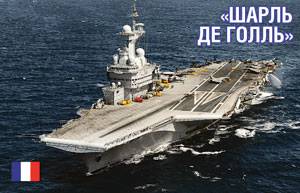 The Brazilian "Sao Paulo", the former French "Foch", was launched as much in 1960 year. But in 1992, it was still undergoing a profound modernization under the former flag, so it is quite a modern ship for technical equipment. Its total displacement is 32 thousand tons. The twin-shaft steam turbine plant with a total power of 126 thousands of horsepower provides the design speed of 30 knots. The range is up to seven thousand miles at an economic speed of 18 knots. The air group of the ship includes X-NUMX A-14UK Skyhawk attack aircraft, helicopters: six anti-submarine SH-4A / B Sea King, two search and rescue, three transport (Super Puma), and also three C-3A transporters, Trader "And the DRLO aircraft of its own design based on C-1A. Total - 1 aircraft. The number of preparation positions is 31. The experience of the combat use of the ship in the French fleet makes it possible to estimate the maximum number of sorties from an aircraft carrier by reserves of fuel and ammunition within 12 – 200, which ensures intensive combat operations for five to seven days (maximum intensity - 220 – 50 departures per day). São Paulo has two steam catapults that enable the use of aircraft weighing up to 55 tons from an aircraft carrier. The armament of the ship is represented by air defense systems - two launchers of the “Albatross” air defense missile system for the “Aspid” SAM and two 20-mm AU of the Bofors company.
The Brazilian "Sao Paulo", the former French "Foch", was launched as much in 1960 year. But in 1992, it was still undergoing a profound modernization under the former flag, so it is quite a modern ship for technical equipment. Its total displacement is 32 thousand tons. The twin-shaft steam turbine plant with a total power of 126 thousands of horsepower provides the design speed of 30 knots. The range is up to seven thousand miles at an economic speed of 18 knots. The air group of the ship includes X-NUMX A-14UK Skyhawk attack aircraft, helicopters: six anti-submarine SH-4A / B Sea King, two search and rescue, three transport (Super Puma), and also three C-3A transporters, Trader "And the DRLO aircraft of its own design based on C-1A. Total - 1 aircraft. The number of preparation positions is 31. The experience of the combat use of the ship in the French fleet makes it possible to estimate the maximum number of sorties from an aircraft carrier by reserves of fuel and ammunition within 12 – 200, which ensures intensive combat operations for five to seven days (maximum intensity - 220 – 50 departures per day). São Paulo has two steam catapults that enable the use of aircraft weighing up to 55 tons from an aircraft carrier. The armament of the ship is represented by air defense systems - two launchers of the “Albatross” air defense missile system for the “Aspid” SAM and two 20-mm AU of the Bofors company.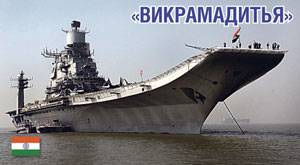 Summarizing the analysis of tactical and technical data, we note that the combat capabilities of the mapped are almost entirely determined by the composition of their air groups. Air defense systems of ships are designed for self-defense and do not have a significant impact on the integral assessment.
Summarizing the analysis of tactical and technical data, we note that the combat capabilities of the mapped are almost entirely determined by the composition of their air groups. Air defense systems of ships are designed for self-defense and do not have a significant impact on the integral assessment.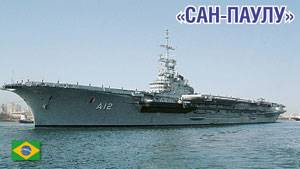 The most powerful airline group has "Charles de Gaulle". At the same time, it is focused on solving shock tasks - the fight against enemy surface ships and its ground targets. The other two are more versatile: in addition to attack aircraft, they include anti-submarine helicopters in a squadron. The weak point of Vikramaditya (like Kuznetsov and Liaoning) is the absence of an ARLO aircraft as a part of the air group. True, and “Sao Paulo” in this regard, very limited opportunities.
The most powerful airline group has "Charles de Gaulle". At the same time, it is focused on solving shock tasks - the fight against enemy surface ships and its ground targets. The other two are more versatile: in addition to attack aircraft, they include anti-submarine helicopters in a squadron. The weak point of Vikramaditya (like Kuznetsov and Liaoning) is the absence of an ARLO aircraft as a part of the air group. True, and “Sao Paulo” in this regard, very limited opportunities.From the point of view of air defense, “Indian” stands out - it has the most powerful complex of this weapons. “Charles de Gaulle” is slightly behind. Yielding to the range of air defense weapons, it has an approximately equivalent destructive potential. Both are able to repel EHV group attacks of up to four to six units in a raid. The “Brazilian” is significantly lagging behind in the capabilities of air defense systems, being able to defend itself only from single air defense missiles of the RCC type.
Combat capabilities
The task of fighting the enemy aircraft carriers, as a rule, is solved in the course of a sea battle lasting up to a day. The parties in this case will use all the available potential, since they are dealing with an extremely powerful and well-defended adversary.
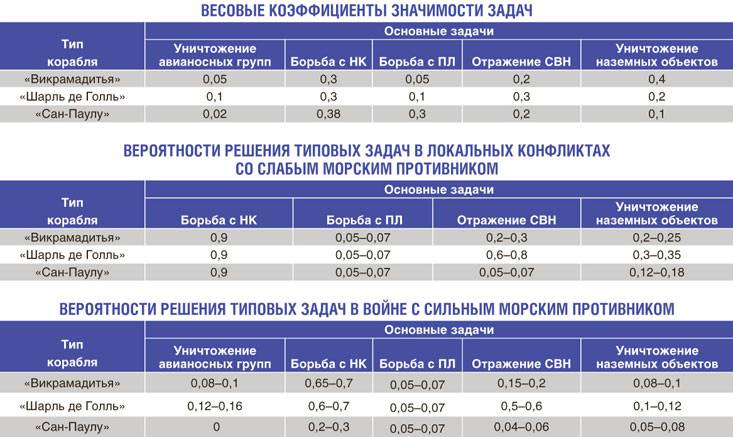
Let's start with the "Frenchman". Up to the medium-term perspective, only Kuznetsov, in extreme cases Liaoning, can become his opponent. To solve the problem, “Charles de Gaulle” has only Rafale-M and Super Etandard airplanes. Their combat capabilities make it possible to strike at the Russian aircraft carrier group, without entering the zone of reach of its long-range anti-ship missiles. You can complete up to 60 sorties in 24 hours, but no less than 16 of them - to provide patrols of fighters in the air in the air defense system of the formation and six to eight - to repel a retaliatory Russian strike. Less than four positions for the use of helicopters and air defense fighters at the same time a maximum of 12 machines can be involved in the attack. At least four of them are in the airspace clearing group. There are eight “Rafaleas” left, each of which has four RCCs AM-39 suspended, in total - 32. And such attacks of the French aircraft carrier will be able to inflict on the strength of three. Our aircraft carrier will counter the two-four cars from the position of duty in the air and four more - from the position of duty on the deck. Of these, three or four will be connected by fighter combat clearing the airspace. The rest attack the strike group. As a result, one or two French aircraft can be destroyed. Others, maneuvering and dodging our fighters, will approach the line of hitting alone or in pairs with a volley of four or eight anti-ship missiles AM-39. It should be noted that the launch range of AM-39 - 50 kilometers from low altitudes and 70 kilometers from large - will force aircraft to enter the range of the long-range and medium-range air defense missile systems of the Russian naval compound, if the newest and most modern missile cruiser, frigate and destroyer. And the warhead of the AM-39 - just 150 kilograms. Based on these data, the estimated estimate of the probability of decommissioning the Russian aircraft carrier - 0,12 – 0,16.
Given the likely nature of the military-political situation, it makes sense to consider the possibilities of Vikramaditya to fight the enemy aircraft carrier forces only in relation to the Chinese Liaoning. "Indian" per day will be able to perform up to 40 sorties by Mi-29K / KUB fighters. Of these, at least 18 – 24 will be required to secure the air defense connection. Less than four positions for the use of helicopters and air defense fighters at the same time a maximum of 10 machines can be involved in a strike. Of these, at least four will be involved in the airspace clearing group. There are six MiG-29K / KUB left, on each of which no more than four X-35 RCCs can be suspended (on the other nodes air-to-air missiles are placed). Total - 24 PKR. Such strikes Indian aircraft carrier will be able to inflict a maximum of two. The capabilities of the Chinese "Liaoning" to repel an air strike are approximately the same as in Kuznetsov.
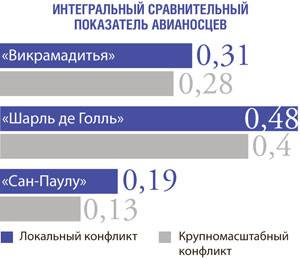 The only potential opponent of the Brazilian "Sao Paulo" - an American aircraft carrier. The maximum combat radius of the Skyhawk is about 500 kilometers. Among the most modern weapons suitable for strikes against surface targets, only the Maverick missiles with a range of about 10 kilometers and a warhead weighing 65 kilograms. With the depth of the American AUG air defense system, even without the support of coastal AWACS aircraft more than 700 kilometers, the Brazilian aircraft carrier has no chance. In part, the successful experience of using Skyhawks during the Anglo-Argentine conflict over the Falkland Islands is not applicable, since the air defense system of the British compound was incomparably weaker than the typical American AUG.
The only potential opponent of the Brazilian "Sao Paulo" - an American aircraft carrier. The maximum combat radius of the Skyhawk is about 500 kilometers. Among the most modern weapons suitable for strikes against surface targets, only the Maverick missiles with a range of about 10 kilometers and a warhead weighing 65 kilograms. With the depth of the American AUG air defense system, even without the support of coastal AWACS aircraft more than 700 kilometers, the Brazilian aircraft carrier has no chance. In part, the successful experience of using Skyhawks during the Anglo-Argentine conflict over the Falkland Islands is not applicable, since the air defense system of the British compound was incomparably weaker than the typical American AUG.The task of combating groups of surface ships will be one of the main tasks in gaining superiority at sea in a given operational area. Its duration can range from three to four to six to eight days. In local military conflicts, targets of ship strikes aviation there will be light forces, primarily groups of missile boats. In a large-scale war against the modern fleets of the developed naval states, the main efforts will focus on the defeat of the KMG from cruisers, destroyers, frigates and corvettes of the URO, amphibious assault forces (DESO), convoys (KON) and the KKE.
In local conflicts, judging by experience, the task of counteracting two to five CBGs of two or three missile boats each can become important. For the defeat of any such group, it is enough to single out two or three pairs of strike aircraft or helicopters with anti-ship missiles and NURS. The probability of the destruction of enemy boats in the group will be close to the guaranteed - 0,9 and more. A total of this task will require up to 30 departures. That is quite achievable within five to six days for all considered aircraft carriers, in which it will be 7 – 8 percent for de Gaulle, 9 – 10 percent for Vikramadity, 13 – 14 percent for Sao Paulo.
In the Mediterranean zone, the “Frenchman” will presumably have to solve the tasks of defeating the limited forces of the Russian squadron consisting of one or two CCF, as well as three to five different ship groups of the fleets of our allies, in particular Syria. Eight “Rafaley-M” are capable of crushing the Russian KUG with a cruiser (0,3 or more - any others) with probability of 0,38 – 0,9. Groups of eight "Super Etandar" with probability 0,7 – 0,85 disable ship groups of countries allied to the Russian Federation. The disposable resource of the Charles de Gaulle wing will make it possible to allocate seven to eight strike groups of different composition for five to six days to accomplish this task. The expected efficiency of solving this problem by the “Frenchman” is estimated at 0,6 – 0,7.
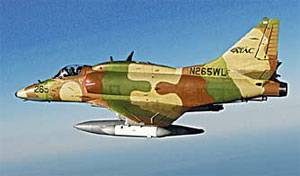 The main opponent of the Indian aircraft carrier will be the fleet of Pakistan. The ship’s composition of the latter makes it possible to form up to five KUG for two or three frigates, two or three KUG for two or three rocket boats and another three to four groups of various purposes. Given the characteristics of the theater, it must be assumed that the destruction of these forces will be one of the most important tasks for Vikramaditya. A group of four MiG-29K / KUB with probability 0,8 – 0,9 will crush any of the named ship groups. Taking into account the aviation resource that can be allocated to solve the problem, it allows to evaluate the effectiveness of such actions in 0,65 – 0,7. It should be noted that the aircraft of both considered aircraft carriers do not have to enter the zone of effective fire ship AIA.
The main opponent of the Indian aircraft carrier will be the fleet of Pakistan. The ship’s composition of the latter makes it possible to form up to five KUG for two or three frigates, two or three KUG for two or three rocket boats and another three to four groups of various purposes. Given the characteristics of the theater, it must be assumed that the destruction of these forces will be one of the most important tasks for Vikramaditya. A group of four MiG-29K / KUB with probability 0,8 – 0,9 will crush any of the named ship groups. Taking into account the aviation resource that can be allocated to solve the problem, it allows to evaluate the effectiveness of such actions in 0,65 – 0,7. It should be noted that the aircraft of both considered aircraft carriers do not have to enter the zone of effective fire ship AIA.São Paulo has a different situation. The most realistic conditions for attracting it to the destruction of surface ships may be a military conflict with neighboring states. In this case, two or four CBFs, two frigates or destroyers, and three or four groups of light forces — rocket boats and other boats and ships, can become possible targets for its aircraft. Skyhawk aircraft to use their weapons will have to enter the zone of effective fire. As a result, with actions in groups of six to eight planes, losses of 20 percent or more are possible. As a result, even with 20 – 25 aircraft departures, losses may become unacceptable. Thus, the "Brazilian" will have time to deliver only three or four hits. The probability of crushing the CUG is from 0,2 to 0,6, depending on the weapon used, weather conditions (Maverick has a homing system operating in the optical range, therefore ineffective in adverse weather conditions or when setting a smoke screen, and if it is impossible to use these missiles, it will have to use free-fall bombs ) and the composition of the group of enemy ships. The expected effectiveness in solving the problem is within 0,2 – 0,3.
An analysis of the composition of the wing of all the samples under consideration gives grounds to conclude that they will fight submarines in the framework of ensuring the military stability of their naval formation. Accordingly, it is advisable to give an assessment according to the criterion of the probability of submarine destruction before its release to the short-range RCC salvo position on warrant ships. This indicator depends on many factors, but the most important of them is the number of helicopters and PLO aircraft simultaneously on duty, as well as the capabilities of their search engines. In all considered air groups - six - eight anti-submarine helicopters with approximately equal potentials. This means that in the duty zone only one helicopter is present on a permanent basis, with the possibility of amplifying up to two in the event of a clear underwater threat. By this indicator, the efficiency of solving PLO problems can be assessed in 0,05 – 0,07 for all three.
The effectiveness of solving air defense tasks is calculated by the percentage of blown-down strikes by enemy aviation against the ships of its formation and other concealed objects. In the local war, “Charles de Gaulle” on a disposable fighter aviation resource will ensure interception of fighter jets five days before 14 – 15 air targets, Vikramadithia - 10 – 12, and Sao Paulo - 6 – 8. The experience of past local conflicts suggests that in the area of responsibility of the air defense of such aircraft carriers it may appear within five days of the order of 15 – 18 air targets. At the same time, the probability of their interception by the Vikramaditya and São Paulo air groups is significantly lower than that of Charles de Gaulle, since they do not have modern DRLO aircraft. Taking into account the combat capabilities of Rafaley-M, MiG-29K and Skyhawks in aerial combat with a likely opponent, the effectiveness of the Frenchman will be evaluated in 0,6 – 0,8, “Indian” in 0,2 – 0,3, and “Brazilian” in 0,05 – 0,08 .
In a large-scale war in the probable area of responsibility of de Gaulle air defense in the Mediterranean, based on its operational mission, the intensity of enemy aviation operations would be comparable to that considered in relation to the Italian Giuseppe Garibaldi - about five to eight groups and individual aircraft, mainly countries Arab world, solving problems in the central and eastern parts of the water area. Almost all of them are really intercepted by pairs of Rafale-M fighters.
"Vikramaditya" in terms of solving the tasks of air defense as the main enemy, most likely, will have the tactical aviation of Pakistan. Within five days in the area of responsibility of the Indian aircraft carrier may be up to 20 and more groups of air targets of different composition. Of these, Vikramaditya is capable of intercepting up to six or eight with MiG-29К / KUB pairs, taking into account the possibilities of detecting air targets and pointing fighters at them.
“São Paulo” in the war with the states of the region (according to the experience of the Anglo-Argentine conflict) will have to solve the problem of countering 15 – 18 groups of planes from squadron to pair and even a single machine for five days. Taking into account the possibilities for their detection, as well as the disposable resource, the “Brazilian” will intercept a pair or link of its “Skyhocks” no more than three or four. In this case, the probability of destruction or coercion to refuse to perform a combat mission will be significantly lower than that of the previously reviewed ships.
It remains to compare the actions of aircraft carriers against ground targets. “Charles de Gaulle” can hit four to five point objects to a depth of 800 kilometers from the coast, taking into account the allocated resource, approximately equal to 0,10 – 0,12 of total operational needs. In a local war, at the expense of a significantly larger resource for solving the problem, the chances are increased to 0,3 – 0,35. “Indian” in the war with Pakistan is able to hit two or three important objects at a distance of up to 600 kilometers from the coast, which is approximately 0,08 – 0,1 from what is needed in a limited operational-critical area. In a local war, this figure rises to 0,2 – 0,25. Brazilian Sao Paulo, given the priority of this task and the disposable resource, is capable of destroying one or two important ground objects at a distance of 350 kilometers from the coast in a war with an equivalent enemy, which corresponds to the efficiency of 0,05 – 0,08. In a local war, this figure will increase to 0,12 – 0,18.
As was to be expected, it most closely matches the conditions of the military use of Charles de Gaulle, in this respect it is ahead of its closest competitor, Vikramadity, by 54 percent for limited conflicts and by 42 percent for large-scale ones. With an almost equivalent in quality, the air group “Vikramaditya” has about one and a half times less impact machines. Note that the contribution of the “fight against submarines” task to the integral indicator of these ships is small due to the low importance of its solution. Therefore, it must be assumed that the composition of the Charles de Gaulle air group from fighters, fighter-bombers and support aircraft given in open media would give large values of this indicator. However, we must bear in mind that the task of combat stability of the ship is the most important. Submarines and a weak naval enemy, and even more powerful, will pose a serious threat to Charles de Gaulle, so at least a couple of links of PLO helicopters (six to eight cars) will be placed on board. A similar conclusion can be made with reference to the Vikramaditya air group. The main opponent of India is Pakistan has six diesel-electric submarines. Fighting with them will be carried out mainly by the forces of surface ships of the regional PLO. Indian frigates and destroyers are well-positioned to find and destroy such submarines, so this task is secondary for the Vikramaditya, but it has two links of PLO helicopters to solve it.
Significantly lower rates "Vikramaditya" for solving problems of air defense in comparison with the "Frenchman" are due not so much a smaller number of fighters in the air group, as the lack of airborne early warning aircraft in it. A pair of Ka-31 - inadequate replacement of the E-2C "Charles de Gaulle" neither in quality nor in quantity.
The basis of the Brazilian air group, made up of outdated Skyhocks, does not meet modern requirements in virtually the entire range of tasks of an aircraft carrier. Especially in the air defense part. Significantly increase the capabilities can equip the ship with aircraft and helicopters capable of using anti-ship missiles, with a range of fire that does not require entry into the zone of reach of enemy air defenses, as well as modern fighters with sufficiently powerful radar and air-to-air missiles.
Information